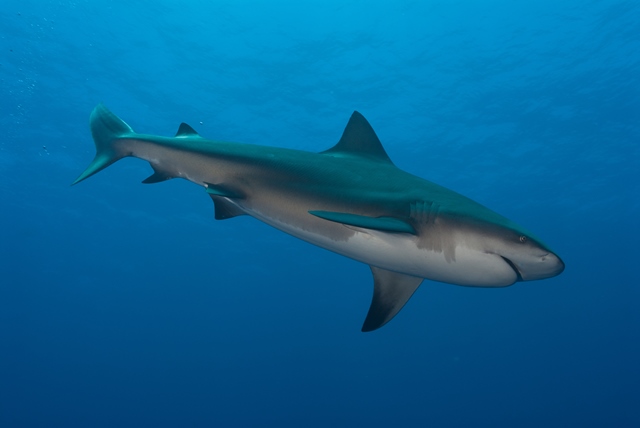
by Rick O'Connor | Jun 28, 2019
The recent attacks on swimmers in North Carolina have once again brought up the topic of sharks. And of course, “Shark Week” is coming up. It is understandable why people are concerned about swimming in waters were animals weighing several hundred pounds with rows of sharp, sometimes serrated, teeth are lurking. It is also understandable that local tourism groups are concerned that visitors are concerned. Sounds like the movie Jaws all over again.
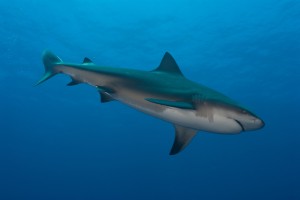
The Bull Shark is considered one of the more dangerous sharks in the Gulf. This fish can enter freshwater but rarely swims far upstream. Photo: Florida Sea Grant
So, what is the risk?
It is good question to ask for anything we feel uncomfortable with. Hiking in Rockies where bears might roam. Hiking in wetlands of Florida or deserts of the American southwest where venomous snakes may lurk. Paddling the creeks and rivers of the American southeast where alligators could be basking. All are concerns.
According to G. Tyler Miller and Scott E. Spoolman, a risk is the probability of suffering harm from a hazard that can cause injury, disease, death, economic loss, or damage. There is a difference between possibility and probability. There is always the possibility of a shark attack, but what is the probability it will happen? Unfortunately, media blast can create a scare over a highly unlikely possibility without discussing the data driven probability of it happening. We all take risk every day – riding in a car, smoking, drinking alcohol, eating bad food – which can lead to heart issues and the number one killer of humans worldwide, and more. Many of these we do not consider risky. We feel we are in control, understand the risk, and are managing from them. Those risk we have little control over – shark attacks – seem more of a risk than they really are. The car is far more dangerous, yet we do not hesitate to get in one at zoom onto the interstate.
Let’s conduct a simple risk assessment of shark attacks…
What is the hazard of concern?
Being attacked by a shark
Dying from the shark attack
How likely is the event?
The International Shark Attack File was first developed after World War II to address the issue of shark attacks on US Navy personnel, but expended to everyone. It was originally housed at the Smithsonian Institute but is currently housed at the Florida Museum of Natural History in Gainesville. Based on their records of unprovoked shark attacks (the ones we are truly interested in) there have been 3103 attacks on humans since 1580. 46% of those were in the United States, ranking us #1. Number two and three are Australia and South Africa. So as far as nations go, we are number one for attacks. However, this equates to 7 attacks / year – worldwide. And not all of those died. Most did not.
Which state?
Since 1837, 828 attacks (57%) occurred in Florida. This equates to 4.5 attacks / year. Florida is number one, followed by Hawaii and California.
What about counties in Florida?
Since 1882 there have been 303 attacks (36%) in Volusia County. This equates to 2.2 attacks/year. The total number of attacks in Florida panhandle counties since 1882 have been 25 – this is 0.2 attacks/year for the entire panhandle.
What were these Floridians and visitors doing when they were attacked?
Surface recreation (surfing, boogie boarding), swimming, and wading top the list, the other activities were logged.
So, there have between 8-10 shark attacks each year, and two fatalities, worldwide.

The white shark is responsible for more attacks on humans than any other species. It is found in the Gulf of Mexico in the winter months but there are no reports of attacks in Florida.
Photo courtesy of UF IFAS
The Risk Assessment is used to develop a Risk Management Plan
First, How do these shark attack data compare with other risks?
I wondered how many car accidents occur each year worldwide?
According to USA Insurance Coverage, who got their data from the National Highway Traffic Administration – 5,250,000 each year in the United States alone. About one every 60 seconds.
Situations that cause human deaths annually in the United States
Heart disease 652,486 1 in 5 people
Cancer 553,888 1 in 7
Stroke 150,074 1 in 24
Shark attack 1 1 in 3,748,067
Between 1992-2000 there were 2 shark attacks in Florida. In that same time period, there were 135 drownings.
Between 2004 and 2013, 361 people drowned in rip currents. During that same period, 8 people were attacked by sharks.
Between 1990 and 2009, in Florida, 112,581 people were involved in bicycle accidents; 2272 died. In that same period, there were 435 shark attacks in Florida; 4 died.
And my favorite…
Between 1984 and 1987, 6339 people had to visit a hospital in New York City because they were bitten by a human. This was 1585 / year. In that same period there were 45 shark attacks in the entire United States. This was 11 / year.
Second, How should we reduce the risk of shark attack?
Well… as you can see from the assessment and comparative risk analysis, many would say you did not need to develop a plan to reduce risk because the risk is too low to fool with. You should spend time on hazards that are of a more real concern. That said, there are some things you can do.
– Avoid excessive splashing; it is known that sharks are attracted to this. It is also known that more often than not, they move away when they detect the source of the splashing.
– Avoid swimming when bleeding or in water with strong smells (like fish bait); this too will attract them.
– Most unprovoked attacks occur between 11:00 AM and 3:00 PM. But honestly, that is when most people are in the water. This could be different if most of us swim after sunset. That said, we recommend that you reduce swimming at dawn and dusk.
I hope this clear up some of the concerns about shark attacks. Yes, they do happen – but infrequently. There are some things you can do to reduce your risk, but these should not keep you from enjoying water related activities. Enjoy your time here on the Gulf coast. Be careful driving and try to eat healthier.
References
International Shark Attack File. https://www.floridamuseum.ufl.edu/shark-attacks/.
Miller, G.T., S.E. Spoolman. 2011. Living in the Environment. 16th Edition. Brooks and Cole, Cengage Learning. Belmont CA. pp. 121.
USA Insurance. https://www.usacoverage.com/auto-insurance/how-many-driving-accidents-occur-each-year.html.
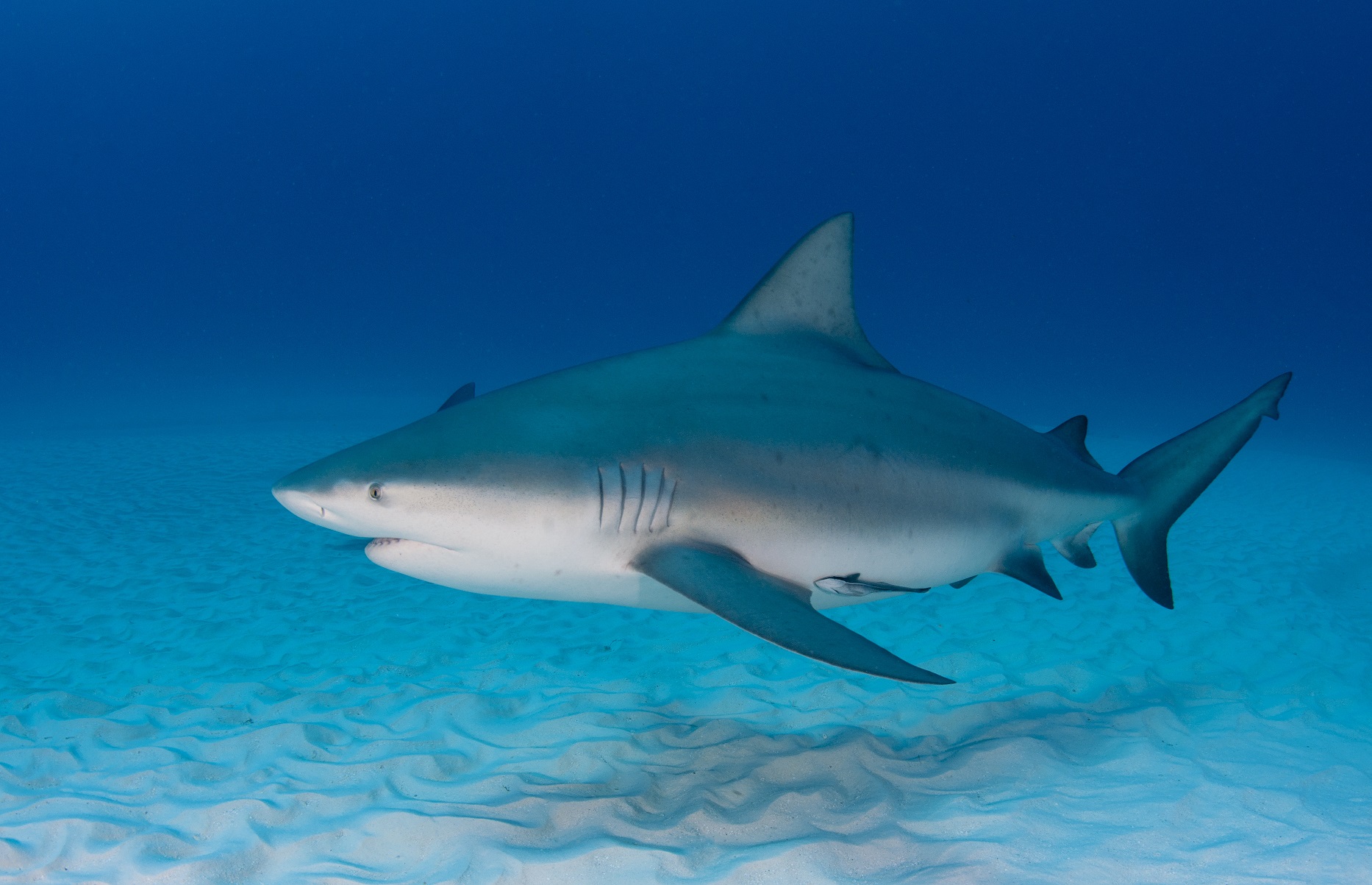
by Rick O'Connor | Aug 3, 2018
In recent weeks, the country has heard about shark attacks off the Carolina coast and great whites off the northern coast of the Gulf of Mexico – then of course, we just completed “Shark Week”. This sometimes makes visitors to our beaches a bit unnerved about swimming. Each year we hear about how other activities we engage in are much more dangerous than swimming in the Gulf where there are sharks – and this is true – but we may still have a concern in the back of our minds. So – we will give you some information that will hopefully enlighten you on the issue of sharks.
First, what kind of sharks are in the Gulf and how common are they?
According to Dr. Hoese and Dr. Moore from Texas A&M, there are 30 species of sharks who have been found in the Gulf of Mexico – and this includes the great white. They range in size from the Cuban Dogfish (3 ft.) to the whale shark (60 ft. in length). Each has their own niche. Some, like the large whale sharks, are plankton feeders. Others, like the blue and mako, are open ocean travelers covering large stretches of water hunting prey. Others, like the blacktip and spinner, are more common near shore – close to estuary outfalls where food is plentiful. And others still, like nurses sharks, are bottom dwellers feeding on slow fish and crustaceans.

The Bull Shark is considered one of the more dangerous sharks in the Gulf. This fish can enter freshwater but rarely swims far upstream. Photo: Florida Sea Grant
As far as how common they are – I was involved in shark tagging in the early 1980’s and we tagged several species. Blacktips and spinner sharks were very common. We also tagged a lot of bull and dusky sharks – though dusky sharks are declining. Tiger sharks were not as common at the time. It was believed this was due to an increase in shark rodeos in the 1970’s – which were popular during the “Jaws” films. However, those events stopped for several years and recent shark events have once again captured tigers. There are five species of hammerheads that were tagged – the scalloped and bonnethead were the most common. White sharks and makos are in the Gulf but were never tagged. It was believed they spent more time offshore (where we were not sampling). Both species have been seen closer to shore in recent years, but there are no reports of any problems from this. It is possible they have been doing this all along and were just undetected. Blacknose, finetooth, and silky sharks were also frequently tagged.
People are probably not surprised to hear that sharks frequent the bays. Many of the species mentioned above do so. The small (3 ft.) Atlantic sharpnose shark is one of the most common. Sawfish were once common in the estuaries but have declined significantly across the region to do over harvesting in the early 20th century. They are currently protected.
You have probably also read that bull sharks have been found in freshwater rivers – and this is the case. Some have been found several miles up river systems.
What type of prey do sharks prefer and how to do they select and hunt for them?
This, of course, varies from species to species. Plankton feeding whale sharks generally cruise slowly through the water column filtering small fish and crustaceans – the same as the great whales. They do tend to feeding in deeper water during the day and closer to the surface at night. They are following what is known as the Deep Scattering Layer. This is a large layer of zooplankton (animal plankton) that migrates each day – deeper (600 feet or so) during the daylight hours and closer to the surface in the evenings.
Bottom dwelling sharks feed on benthic creatures like flounder and crabs. Many have the ability to detect their prey buried beneath the sand using electric perception they have.
Many species of sharks are what we call “ram-jetters”. This means they do not have a pump system to pump water over their gills. So, in order to breath, they must swim forward. Swimming continuously requires a lot of energy. Most of them are what we call opportunistic feeders – meaning they will grab what they can. Stomach analysis of such sharks find primarily fish and squid, but other creatures have been found – such as birds and even other sharks. The general rule here is seek prey that is “easy”. If your objective in feeding were to obtain energy – it would not make since to chase prey that would require a lot of energy to catch. Simple first, and take opportunities when you can. It is the ram-jetter species that people are most concerned. Swimming and taking opportunities. However, evidence suggest that we are not a prey of choice, not good opportunities. More on this in a minute.
Tiger sharks are interesting. It is in their stomachs we find such things as hubcaps, metal, and other sorts of garbage. Because of their tooth design, they are also capable of eating sea turtles.
How often do shark attacks on humans actually occur and what were the people doing that may have enticed it to happen?
Records on human shark attacks are kept at the International Shark Attack File at the Florida Museum of Natural History in Gainesville, FL. This data set only logs unprovoked attacks – those where the people were doing their thing and all of a sudden… Not those where humans were pulling them into their boats after fishing or grabbing their tails while diving.
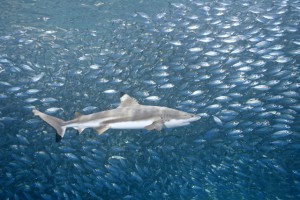
Blacktip sharks are one of the smaller sharks in our area reaching a length of 59 inches. They are known to leap from the water. Photo: Florida Sea Grant
Based on this data – there have been 3031 unprovoked shark attacks reported worldwide since 1580 A.D. This equates to seven attacks / year. Granted… not all attacks are reported, particularly from the undeveloped regions of the world – and from early history, but it does give us something to look at.
Currently, we are averaging between 70 and 100 shark attacks worldwide and between 5-15 of these are fatal. Honestly, this is very low when compared to other activities in which humans participate.
| Year |
Deaths from Other |
Deaths from Shark Attacks |
| 1959 – 2010 |
Lightning strikes – 1970 |
26 |
| 2004 – 2013 |
Rip Currents – 361 |
8 |
| 2001 – 2013 |
Dog bites – 364 |
11 |
| 2000 – 2007 |
Hunting accidents – 441 |
7 |
| 2002 – 2013 (Florida only) |
Boating accidents – 782 |
2 |
As you can see… the risk is much lower.
It is true that most of the shark attacks worldwide are in the United States (46%) and that most in the U.S. are in Florida (56%). However, it is believed that this is due to the number of Americans (and Floridians) who enjoy water activities. In Florida, most of the encounters have been on the east coast – 89% of them! There have only been 65 attacks reported from the west coast – only 37 from the Florida panhandle – since 1580 A.D. There have only been six reported from Escambia County and one from Santa Rosa in that time.
As far as what people were doing when a shark attack occurred – most were surfing, but swimming has increased in recent years. This is believed to be connected to the increase in the number of humans swimming. The human population visiting beaches, particularly in the U.S., has increased significantly. Most shark attacks occur in near shore waters – which would make sense… that is where we are. Most are the “hit & run” version – meaning the shark hits the person and runs… not returning. Based on Florida reports, it is believed most of these are blacktips, spinners, and blacknose sharks. These rarely end in a fatality. “Bump & Bite” – meaning the shark circles, bumps the person, and then bites, are not as common. It is believed most of these are from great whites, tigers, and bull sharks. The few fatalities that happen are usually from this form of encounter.
Summary
When assessing “risk” in an activity you have to consider “control”. This means that the more you are in control of the situation, the less risky the activity seems to be. Most feel that in the water, the shark is in control – this increases our fear and risk concern. However, as mentioned in this article, many of the other activities we are involved – where we think we are in control – are far more risker than swimming on the open Gulf of Mexico.
However, shark attacks do occur and there are a few things swimmers can do to reduce their risk.
- Do not swim alone – all predators will try and isolate an individual from a group before they attack – much easier to attack an individual than a group
- Do not swim near dusk or after dark – to increase their chance of hunting success, sharks are more actively hunting in low light conditions
- Remove shiny objectives like jewelry – sunlight hitting metal objectives can appear to be baitfish to a shark
- Avoid blood in the water – it is true they have an excellent sense of smell – small amounts of blood in the water can be detected as far away as 100 feet suggesting easy prey nearby. Avoid swimming near fishing activity where bait and fish blood may be discharged into the water
I have been swimming in the Gulf all of my life. It is too much fun to worry about a low risk encounter with a shark. Follow the simple rules suggested by the ISAF and you should not have any problems.
Resources
The International Shark Attack File – https://www.floridamuseum.ufl.edu/shark-attacks/.
Hoese, H.D., R.H. Moore. 1977. Fishes of the Gulf of Mexico; Texas, Louisiana & Adjacent Waters. Texas A&M Press, College Station TX. pp. 327.
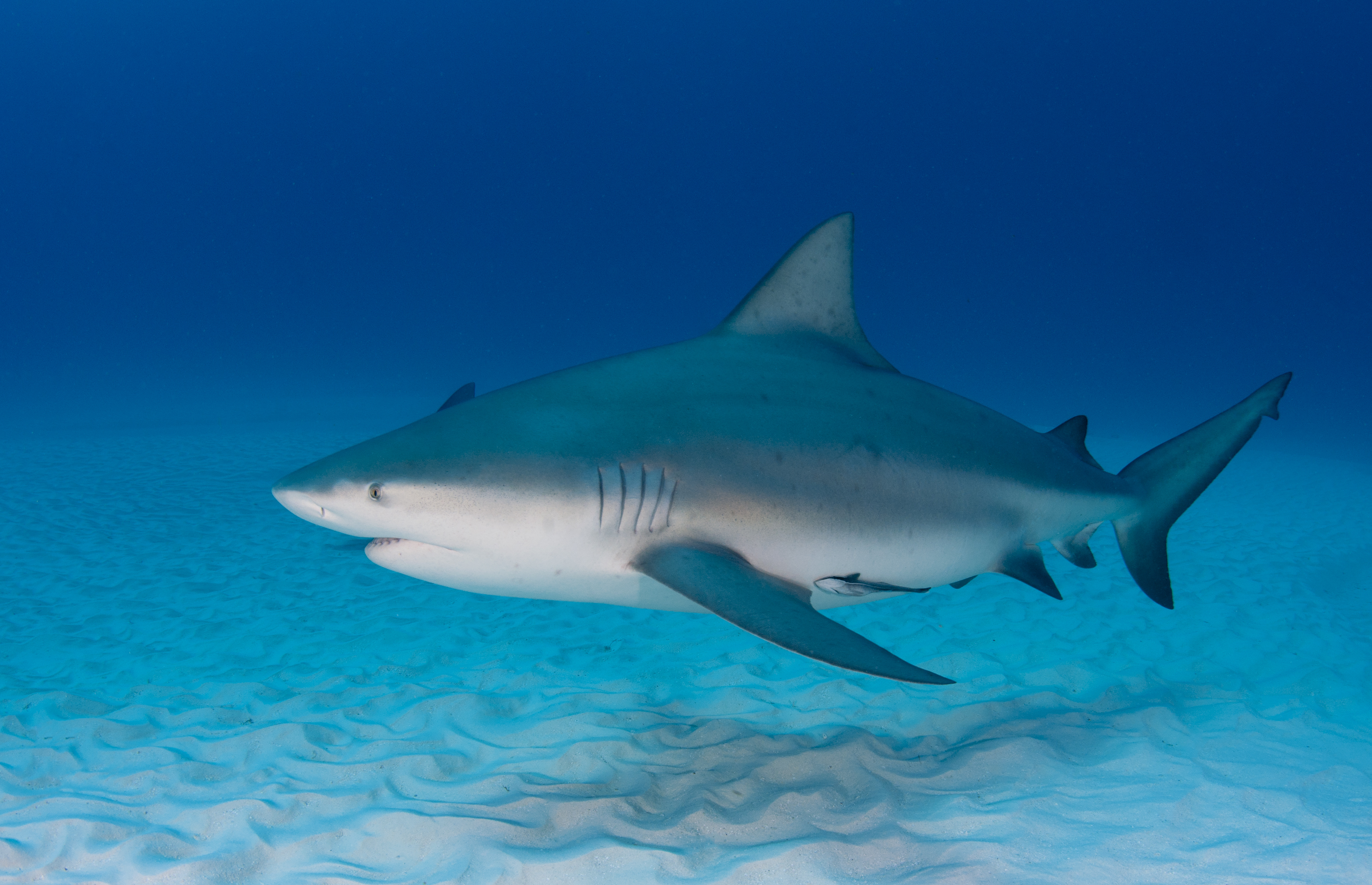
by Rick O'Connor | Jul 12, 2017
I am calling this “Summer of Sharks” as if this summer is more of a problem than others are. In fact, it is not… no more, so than any other summer –so we could call any summer the “summer of sharks”.
“Shark Fever” is more correlated with when and how the press covers the topic. During summer, more people see sharks near shore – and this is unnerving. So are there more sharks? Are there more attacks? Do the unusually warm winter and Gulf waters cause the increase?

Pregnant Bull Shark (Carcharhinus leucas) cruses sandy seafloor. Credit Florida Sea Grant Stock Photo
Let us start with the first question – are there more sharks in the Gulf than there used to be?
Though most of the papers I reviewed were published over 10 years ago – they suggest several species of sharks have actually been on the decline due to incidental catch in long line operations. This reduction due to by-catch suggest a need for population management. According to the NOAA Fisheries site, the quota for commercial sharks in the Eastern Gulf of Mexico for 2016 was 127.8 metric tons (amount varied by species). The actually percent of the quota landed was around 70%. In the Western Gulf during 2016, 350.4 metric tons were allowed and between 49 – 141% of the quota (depending on species) was logged by March of 2016; at which time those federal waters were closed to shark fishing. So far, in 2017 the Western Gulf is again closed due to quota already taken while the Eastern Gulf has reached between 30-40% of the quota.
These data suggest that the fishermen in the Western Gulf are either dealing with a lot of sharks and making the quota quickly or there is heavy fishing pressure on this population.
So why more coastal encounters?
Discussing the recent increase in contact between anglers and mako sharks near Pensacola, Dr. Wayne Bennett (University of West Florida) believes this is due to more divers/fishermen in the environment and thus more encounters; and not more makos interested in inshore waters. In other words, they have always been here – there are just more of us in the environment, and thus more of us seeing them. With Go-pros and cell phones, these encounters are moving through social media and more of us are aware of these encounters. Dr. George Burgess (University of Florida) has a similar comment about recent white shark encounters along the Gulf coast.
Are there more attacks?
To answer this – we review the International Shark Attack File housed at the Florida Museum of Natural History at the University of Florida.
According to the ISAF data – 2016 was “average”. 84 unprovoked shark attacks occurred worldwide in 2016; compared to the annual mean of 82. 2015 however was a busy year with 94 unprovoked attacks logged. ISAF goes on to state there is a correlation between the time humans spend in the sea and the number of attacks that occur. They go on to state that if shark populations remain the same or increase; you might expect an increase in attacks. However, if the populations were low or declining, you would expect a decrease in attacks.
ISAF has unprovoked shark attack data going back to 1580. During that time, the United States and Australia account for 67% of all attacks – but these are two nations where the citizens really love water sports. The U.S. alone accounts for 46% of all attacks. Within the U.S., Florida accounts for 58% of all shark attacks, followed by Hawaii, California, and the Carolina’s – all states where water sports are very popular.
Just because we are interested – in Florida, 54% of the attacks have occurred in Volusia (Daytona) and Brevard counties – both very popular with the surfing public. Along the Florida Panhandle, we have Bay County (Panama City Beach) with 9 attacks, Escambia (Pensacola Beach) with 6, Okaloosa (Destin) with 3, Gulf (Port St. Joe) and Franklin (St. George Island) both with 2, and finally Walton (Seaside), and Santa Rosa (Navarre) both with 1 attack each. This is a total of 24 attacks that equates to 3% of the total number of attacks in the state of Florida since 1580.
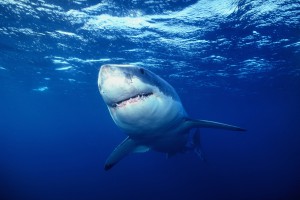
White Shark (Carcharhinus carcharias). Credit: Florida Sea Grant Stock Photo
So what does all of this mean?
- There is concern about the decline of some shark populations due to either commercial catch or commercial by-catch. NOAA is trying to manage this.
- More people are encountering sharks, but this in not believed to be due to more sharks in the water – actually, because there are more people in the water.
- Shark attacks are rare, and in the panhandle – very rare.
Therefore, the sharks are here and it is fair to say that if tourism in the Panhandle continues to increase the number of human-shark encounters will as well. It will continue to be “the summer of sharks”.
Resources:
Sharks in the Gulf of Mexico: Facts
http://www.pewtrusts.org/en/research-and-analysis/fact-sheets/2012/03/12/sharks-in-the-gulf-of-mexico-the-facts
Shifting baselines and the decline of pelagic sharks in the Gulf of Mexico
http://onlinelibrary.wiley.com/doi/10.1111/j.1461-0248.2003.00564.x/full
Atlantic Shark Commercial Fishery Landings and Retention Limit Update from January 1 – December 31, 2016
http://www.nmfs.noaa.gov/sfa/hms/news/news_list/2017/1/shk_landings_update_011717.html.
ISAF 2016 Worldwide Shark Attack Summary
https://www.floridamuseum.ufl.edu/fish/isaf/worldwide-summary/

by Rick O'Connor | Jul 1, 2016
Yep, each year cable TV broadcast their classic summer series SHARK WEEK. Actually there are several shark series running now. It all began with Jaws in the early ‘70’s and ever since Americans have been enthralled with programs on these animals.
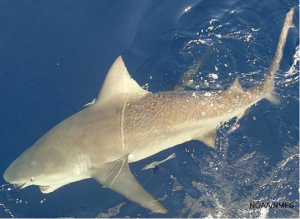
Bull shark (Carcharhinus leucas). Gulf of Mexico. Credit: SEFSC Pascagoula Laboratory; Collection of Brandi Noble, NOAA/NMFS/SEFSC.
We have learned a lot about sharks over the years, and have a better understanding of their behaviors. As fascinating as that information is, it is still the cause of attack that interest most people. There is a great fear of these animals, despite the statistics that say the risk of attack is very low. Millions will watch Shark Week with wonder and awe… and will be a little reluctant to enter the water afterwards. Of course the attacks that occurred on the Carolina’s last summer has some on edge.
So what is the actual risk? In the June edition of Smithsonian magazine there is an article that discusses the possibility of actually eliminating mosquitoes from our environment – that’s another story – but in the article they quote some statistics from the National Institute of Health. They mention the number of humans who die from mosquito bites each year. According to this data 725,000 humans die each year, worldwide, from diseases transmitted from mosquito bites. Between 20,000 and 200,000 from parasites transmitted by snails. Between 55,000 and 60,000 rabies transmitted from dogs. And for shark attacks… 6. Annually 6 people die each year from shark attacks. Think about that… the number of humans who swim in the world’s oceans each year… approximately 50 will be attacked and 6 will die. It is fair to say that the risk is very low.
Dr. George Burgess, Florida Museum of Natural History, is the “keeper” of the International Shark Attack File. This database houses all the unprovoked shark attacks that occur worldwide. By definition an unprovoked attack must (1) occur in its natural environment – no bites in aquariums will count, (2) the individual did not grab or poke at the shark. Biting the boat is not considered an attack under their definition either. Based on this, 2015 was a record year. 164 attacks were reported worldwide, 98 of these were logged as unprovoked. This broke the 2000 record of 88 however only 6.1% of the 2015 attacks were fatal – compared to 11% in 2000. Dr. Burgess stresses this point. What we are seeing is an increase number of swimmers in the oceans each year. It is only natural that the number of attacks would go up. Even though the number of attacks are increasing the number of people entering the water is increasing at a greater rate – the actual rate of attacks/human in the water is decreasing, and has been for over a decade now. Another factor in the increase number of attacks is the University’s improved method of collecting data. Originally it was by word of mouth and phone calls. Today with go-pros, cell phones, and the internet, they are logging attacks that were missed in previous years.
Why are fatalities so low?
Dr. Burgess points to better safety procedures and first aid, particularly in the U.S. 59 of the 98 shark attacks logged last year were in the United States. Six of these were fatal (1.7%) which is much lower than the rest of the world (12.8%). Dr. Burgess states that our safety and first aid programs are responsible for this. Florida ranks number one among states with 30 attacks. This probably does not make the visitor to our area feel good, but most of these were in Volusia and Brevard counties. There were no attacks in the Florida panhandle in 2015. Of those attacked, 49% were surfing, 42% were swimming, 9% snorkeling, and no attacks occurred for SCUBA divers.
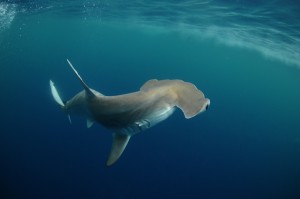
The Scalloped Hammerhead is one of five species of hammerheads in the Gulf. It is commonly found in the bays. Photo: Florida Sea Grant
Many of these statistics still make folks nervous but when compared to parasites and motorcycle accidents, the risk is very low. Sharks are actually fascinating creatures which provide ecological services to our system – such as culling sick and diseased snapper, creating a stronger healthy snapper population. The majority of the programs shown during Shark Week will not discuss these characteristics of the creature but focus on attack stories. Well… enjoy the shows but remember that, though shark attacks do occur, and they can be horrific, they are very rare and should not keep you from enjoying our Gulf.
Enjoy your holiday.
by Rick O'Connor | Sep 19, 2015
Most of us remember the string of shark attacks that occurred this past summer in North Carolina; as a matter of fact, according to the International Shark Attack File, it was a record year for that region. Since 2001 there have been 34 shark attacks in North Carolina ranging from 1-5 per year (average 2.4 attacks / year); this year there were 8 attacks. Why the increase?
Reviewing the trend data we can see that the human population has increased, attendance at local beaches has increased, the number of tourists to our beaches has increased, and the shark attacks have also increased. But could the actual number of sharks be increasing as well? A recent report suggest… maybe.

Pregnant Bull Shark (Carcharhinus leucas) cruses sandy seafloor. Credit Florida Sea Grant Stock Photo
Since 1986 NOAA’s Northeast Fisheries Science Center has been capturing and logging sharks along the southeast coast of the United States. This year’s survey logged 2,835 sharks between North Carolina and Florida; most were Sandbar’s, Atlantic Sharpnose, Dusky, and Tiger sharks. This is an increase from 1,831 in 2012 and higher than any year since the surveys began.
Are they getting better at catching shark? Maybe… but scientific surveys require that the team use the same protocol each year when conducting such surveys, suggesting that there are in fact more sharks out there. If this is so, why are there more sharks?
Well you first have to confirm that this is in fact the case – sharks are in fact increasing. But scientists can begin looking at data that could explain it. Typically you would begin with their food supply and predation. Though we now know that increase in food supply does not always equate to an increase in predators, it is data that should be reviewed. And what about predators of sharks? Which is typically us.
A review of the NOAA shark landing data indicates that 5 of the 9 shark categories have been closed as of June 22, 2015 because they have landed a significant percentage of their allowed quota for the year. This equates to good fishing… which could mean more sharks. Discussing with local divers in the Pensacola area, they believe they are seeing more sharks – and the increase seems to be closer inshore. It is an El Nino year, and environmental conditions change during these seasons. It is known that environmental changes will certainly trigger changes in fishery numbers and distribution.
As the scientific process works itself out, we will learn more about what is occurring with sharks in U.S. waters. In our state the Florida Fish and Wildlife Conservation Commission protects 25 species of sharks. Anglers are allowed one non-protected species and no more than 2 per vessel. (Learn More). More should be known once the 2015 season comes to an end. Why shark numbers in North Carolina have increased is not understood at this time but monitoring will continue.











